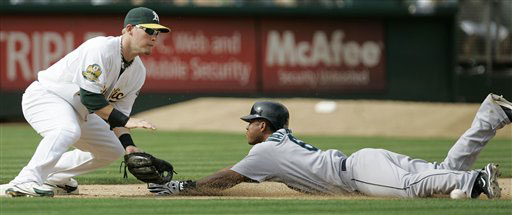In Baseball, Head-first Slides Are Best

A player's slide to beat the throw at home plate is one of baseball's big thrills, especially during the postseason, which begins today. But of the two sliding styles — head-first and feet-first — which is faster?
Head-first, says David A. Peters of Washington University in St. Louis, an engineer and avid baseball fan.
The reasons that it's faster to lead off with your noggin all have to do with physics, Peters said.
Specifically, it's a matter of the player's center of gravity (or center of mass) — essentially the point where gravity exerts its tug. For most people, their center of gravity is right around the stomach area, Peters said.
Whenever you leave the ground, no matter which end of your body you lead with, your center of gravity will move forward with the speed (and momentum) you left the ground with, Peters explained.
Two factors make you reach the base sooner if you dive head-first, Peters told LiveScience. One is that your arms are lighter than your legs, which means that as your body rotates, your arms are going to extend out farther than would your legs. Also, because your feet are still pushing off the ground as you dive, you can get a little extra acceleration.
If you slide feet-first, your feet will dig into the ground instead, slowing your motion, Peters said.
Sign up for the Live Science daily newsletter now
Get the world’s most fascinating discoveries delivered straight to your inbox.
Some people prefer to slide feet-first though so that they can pop up when they reach the base and avoid sliding past it.
Head-first slides are also more dangerous, Peters said, because players could jam their hands into the base. Until the 1960s and '70s, in fact, players tended to avoid sliding head-first into a base to protect their hands and faces.
Players who do slide this way will often hold their batting gloves in their hands to keep themselves from extending their fingers as they slide, he explained. Just how many players favor each type of slide has never been calculated, but Peters estimates that it's about 50-50.
- Video: How to Throw a Split-Finger Fastball
- Mind Games: What Makes a Great Baseball Player Great
- Baseball Physics: Deception and Battered Expectations

Andrea Thompson is an associate editor at Scientific American, where she covers sustainability, energy and the environment. Prior to that, she was a senior writer covering climate science at Climate Central and a reporter and editor at Live Science, where she primarily covered Earth science and the environment. She holds a graduate degree in science health and environmental reporting from New York University, as well as a bachelor of science and and masters of science in atmospheric chemistry from the Georgia Institute of Technology.










